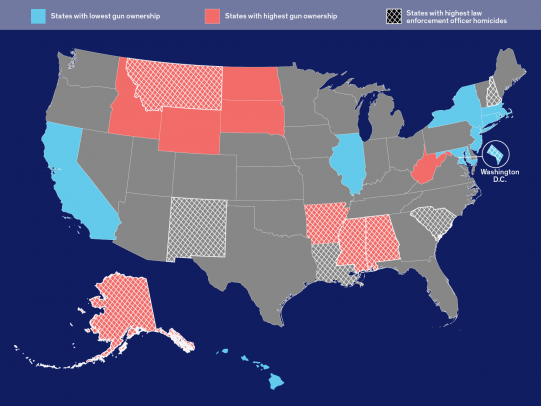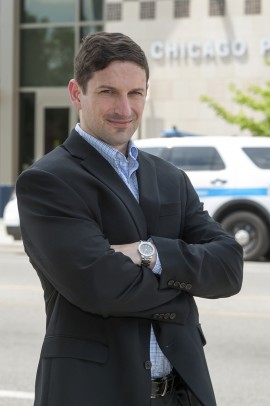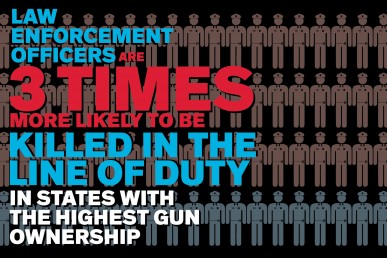Police more likely to be killed on duty in states with high gun ownership

The UIC study found that police officers in states with high private gun ownership are more than three times more likely to be killed on the job than in states with the lowest gun ownership. Illustration: Megan Strand/UIC (Click on image for larger view or to download)
Camden and Newark, New Jersey, are perceived as two of the most violent cities in the nation, yet New Jersey’s police officers are among the least likely to get shot on the job. Montana, with its serene landscapes and national parks, has among the highest homicide rates for law enforcement officers. Why?
Across all 50 states and the District of Columbia, homicides of police officers are linked to the statewide level of gun ownership, according to a new study published in the American Journal of Public Health. The study found that police officers serving in states with high private gun ownership are more than three times more likely to be killed on the job than those on the job in states with the lowest gun ownership.
Previous studies have linked firearm ownership with higher overall firearm death rates in the United States and internationally. Until now, none of the studies have examined the increased risk to law enforcement personnel.
“If we’re interested in protecting police officers, we need to look at what’s killing them, and what’s killing them is guns,” says the study’s lead author, David Swedler, research assistant professor of environmental and occupational health sciences in the University of Illinois at Chicago School of Public Health.
“We know that 92 percent of police officers killed in the line of duty are killed by guns, three-quarters of which are handguns,” Swedler said.

“We know that 92 percent of police officers killed in the line of duty are killed by guns, three-quarters of which are handguns,” says UIC researcher David Swedler. Photo: Roberta Dupuis-Devlin/UIC Photo Services. (Click image to download)
Swedler and his colleagues looked at the homicide rates of police officers by state between 1996 and 2010 using data from the Federal Bureau of Investigation database, which logs every officer killed in the line of duty. Law enforcement homicide rates were calculated as the number of officers killed by guns per number of officers employed in each state.
Statewide gun ownership rates were calculated using the Behavioral Risk Factor Surveillance System, an annual nationwide survey that collects data over a wide range of health topics (including household firearm ownership) as well as state-level data on gun-related suicides, which have been proven to accurately reflect gun ownership rates.
Of the 782 homicides of police officers over the study period, 716 were committed using guns; 515 of them with handguns. States averaged one law enforcement officer homicide per year, but because states vary in the number of officers employed, some had higher numbers of officer homicides, while other states had none.
On average, the researchers found that 38 percent of U.S. households have at least one gun, ranging from 4.8 percent of households in the District of Columbia to 62 percent in Wyoming.
Alabama, Alaska, Arkansas, Mississippi and Montana were in the top quintile both for gun ownership and for law enforcement homicides, while Connecticut, Massachusetts, New Jersey, New York and Rhode Island were in the lowest quintile for gun ownership and police officer homicides.
“We found that officers aren’t being killed in states with high violent-crime rates. While violent crime rates didn’t track closely to officer homicide rates, it was public gun ownership that had the strongest relationship,” Swedler said.
“Hypothetically, officers might be put at increased risk if they are more frequently encountering violent criminals, but our data doesn’t find that to be the case,” said Swedler. “We find that officers are at an increased risk for being killed the more frequently they encounter guns in public settings.”
Swedler says that one reason why high gun ownership and police officer killing are so closely linked is that many officers get shot while responding to domestic disturbance calls.
“Research shows that responding to domestic violence calls are one of the most common situations in which officers are killed. In states where firearms are more prevalent, officers responding to reports of domestic violence are more often entering potentially lethal situations compared to officers responding to such calls in states with lower firearm prevalence,” Swedler said.
Based on their data, Swedler and his colleagues estimate that a 10 percent higher statewide firearm ownership would have resulted in 10 more law enforcement officer homicides in each state over the 15 year study period.
“Statewide firearm ownership is definitely a risk factor for police officers,” Swedler said. “Higher private gun ownership increases the frequency with which officers encounter life-threatening situations. If we care about the safety of those officers, then we need to think about them when considering state gun laws.”
Molly Simmons of the Johns Hopkins School of Public Health and Francesca Dominici and David Hemenway of the Harvard School of Public Health are co-authors on the paper.
Swedler’s work was funded through the Liberty Mutual-Harvard Program in Occupational Safety and Health.

